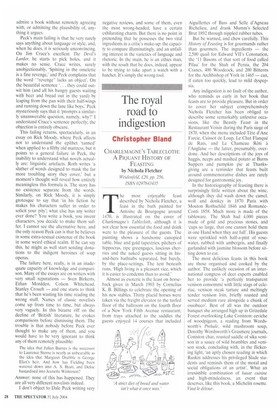The royal road to indigestion
Christopher Bland
CHARLEMAGNE'S TABLECLOTH: A PIQUANT HISTORY OF FEASTING by Nichola Fletcher Weidenfeld, £20, pp. 256, ISBN 0297843435 The most enjoyable feast described by Nichola Fletcher, a feast in the bath painted for Antoine de Bourgogne around 1470, is illustrated on the cover of Charlemagne's Tablecloth, although it is not clear how essential the food and drink were to the pleasure of the guests. The painting shows a handsome canopied table, blue and gold tapestries, pitchers of hippocras, ripe greengages, luscious cherries and the naked guests sitting in hisand-hers bathtubs separated, but barely, by the place-settings. The text beneath runs, 'High living is a pleasant vice, which it is easier to condemn than to avoid.'
Almost as esoteric is the feast on horseback given in March 1903 by Cornelius K. B. Billings to celebrate the opening of his new stables. Thirty placid horses were taken via the freight elevator to the turfed floor of the ballroom on the fourth floor of a New York Fifth Avenue restaurant; from trays attached to the saddles the guests enjoyed 14 courses that included Aiguillettes of Bass and Selle d'Agneau Richelieu, and drank Mumm's Selected Brut 1892 through nippled rubber tubes. But be warned, and chew carefully. This History of Feasting is for gourmands rather than gourmets. The ingredients — the 2,500 quail for Edward VII's Coronation, the '11 Basons of that sort of food called Pilau' for the Shah of Persia, the 204 Cranes, 400 Woodcock, and 200 Bitterns for the Archbishop of York in 1465 — can, if eaten too quickly, lead to mild dyspepsia.
Any indigestion is no fault of the author, who reminds us early in her book that feasts are to provide pleasure. But in order to cover her subject comprehensively Nichola Fletcher has been obliged to describe some remarkably unfestive occasions, like the Beastly Feast in the Restaurant Voisin during the Paris siege of 1870, when the menu included Tete d'Ane Farcie, Cuissot de Loup, Le Chat Flanque de Rats, and Le Chameau ROti l'Anglaise — the latter, presumably, overdone. And her descriptions of the joys of haggis, neeps and mashed potato at Burns Suppers and pumpkin pie at Thanksgiving are a reminder that feasts built around commemorative dishes are rarely designed for gastronomic joy. In the historiography of feasting there is surprisingly little written about the wine, although they did wash down the camel, wolf and donkey in 1870 Paris with Mouton Rothschild 1846 and RomaneeConti 1858. Much more is made of the tableware. The Shah had 4,000 pieces made of gold and precious stones, and 'cups so large, that one cannot hold them in one Hand when they are full'. His guests were sprinkled with half-a-pint of rosewater, rubbed with ambergris, and finally garlanded with jasmine blossom before sitting down to eat.
The most delicious feasts in this book are those organised and cooked by the author. The unlikely occasion of an international congress of deer experts enabled her to provide 'a perfectly transparent venison consommé with little stags of celeriac, venison steak tartarc and meltingly tender venison loin, briefly roasted and served medium rare alongside a chunk of ossobuco'. Best of all was the outdoor banquet she arranged high up in Grizedale Forest overlooking Lake Coniston: ceviche of woodpigeon, a reading from Wordsworth's Prelude, wild mushroom soup, Dorothy Wordsworth's Grasmere journals, Coniston char, roasted saddle of sika venison in a sauce of wild brambles and venison stock, concluding with, in the flickering light, 'an aptly chosen reading in which Ruskin addresses his privileged Slade students and reminds them of the moral and social obligations of an artist'. What an irresistible combination of haute cuisine and high-mindedness, an event that deserves, like this book, a Michelin rosette. Vaut le detour.


























































 Previous page
Previous page